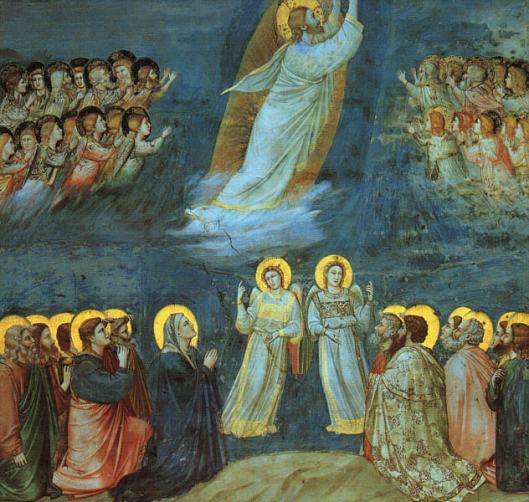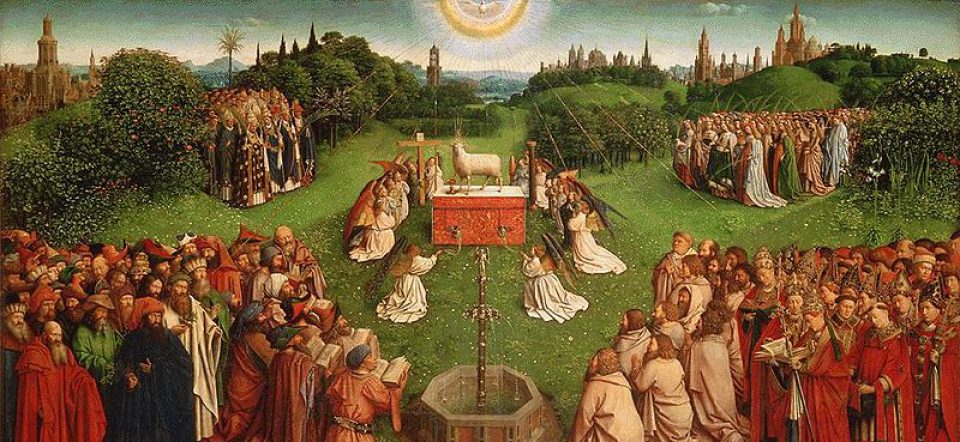
Enluminure: The Sacramentary of Drogo (800-900 AD), one of the gospel illustrated manuscripts from the Carolingian Revival.
The Ascension is one of the most central elements of the Catholic faith, referenced in the Apostles’ Creed. The Resurrection of Jesus and his path to Heaven is intrinsic to His role as Son of God. Jesus ascended 40 days after the Resurrection, and it is one of the most important dates in the Church calendar after Holy Week and Christmas. This year Ascension Thursday is May 25th, a holy day.
Since the teachings of the Church revolve around particular aspects of Jesus’ life and teachings (as well as broader concepts in Catholic theology), especially His eternal life, His dying for our sins, life after death and the victory of good over evil, the Ascension has gained a principal place in the minds of the faithful down throughout the centuries.
In times of hardship, Catholics have looked to the Ascension as an example of the promise of eternal salvation. This has rung true since the early days of the Church, through the Middle Ages to the modern era, when many Catholic communities faced persecution and hardship.
As a result, there is a particularly rich body of Catholic art celebrating the Ascension. The relevance of the Ascension, along with the artistic history of the Church and its followers, makes the Ascension one of the most common themes seen in the corpus of Catholic art. Several of the most famous Catholic artists, especially during the Renaissance period, created inspiring works enjoyed not only by those interested in art but by any of the faithful, especially around the joyous period following Easter.
Other Mediums
Interestingly, other persons in the history of the Church have been depicted in their Ascension, such as Saint John and, of course, the Assumption of Mary. Also, several mediums aside from paintings have been used, notably sculpture, engravings and icons. The types of scenes depicted also vary, and all schools of art have produced works on the topic since about 300 A.D.

Giotto di Bondone “The Ascension” c.1305 located at Scrovegni Chapel, Padua, Italy
Types of Works
The two main types of works produced can typically be classed as relating to either the earthly perspective of the Ascension or the arrival of Jesus in heaven itself. From the earthly perspective, it is interesting that most scenes depict a broad range of figures in the Church, even those that would not have been there to witness it (such as Paul, who was not a Christian at the time of the Ascension, and Mary, who was not believed to have been present). Artists did this to emphasize the importance of Jesus’ ascension applied to all of Christ’s followers, not just those who were present.
In many works, there are symbolic depictions of Jesus common in other portrayed scenes of his life. However, these characteristics became particularly relevant and widespread in Ascension portrayals.
This level of standardization across Ascension scenes is notable for those with an interest in comparative art, since the small differences but many similarities between works can inform us about details of the period when they were produced or the opinions of the artists. As an extreme example, if you compare the Ascension in Catholic versus Eastern Orthodox art, you will note the Eastern tradition always has Mary present, which reflects their belief that Mary was there when Jesus ascended.
There are small details of the Ascension that vary from work to work that can provide interesting comparisons. For example, after the Renaissance, the angels are often not part of the image in most cases, whereas earlier, including angels was considered mandatory.
In the post-Renaissance era, Christ is alternatively shown with a banner in his right hand, or using it to make a blessing. In his left hand, he might have a parchment, scroll or Gospel. The action of the right hand is commonly interpreted to mean that he is blessing the entire community of believers, while the book or scroll he holds in his left represents the need to spread the word of the Lord.
Other details of the Ascension scene have changed significantly over the centuries. It was only starting around the 4th century that the Ascension becomes popular in Christian art. Until then, Jesus’ miracles were much more common material for artistic representation.
The same can be said for the Crucifixion, which was even less commonly depicted than the Ascension. Scholars believe that it may have been due to the many theological conferences and debates between 300 AD and 450 AD that caused the change in art. The turmoil regarding the difference among the various churches throughout the then known world brought Ascension scenes to the forefront as a means to help unify the Church.
Whatever the reason, after this time, it became one of the most popular scenes. In many cases, the artist includes a mountain with the Hand of God aiding Jesus in His ascent.
His feet visible through the clouds is a common element, along with His footprints in rocks along the mountains. The Ascension is commonly held to have taken place on the Mount of Olives near present-day Bethany.
The Ascension has been depicted in many manuscripts, especially in the period of 700-1500, in many reliefs commonly up until around 800 (including the first known depiction of the scene), and of course, the many paintings included painted scenes on church domes.

Andrea Mantegna “The Ascension” 1461 Florence, Italy
Northern Europe
Works by Giotto, Mantegna and Garofalo are among the most famous Ascension works. Given that Northern Europe was mainly Protestant after the 15th century and the Reformation, there are fewer works from artists in those countries.
However, in earlier times, there was a common theme in Northern Europe of depicting the feet of Jesus, extending from the clouds while he is on his way to heaven.
Final Thoughts
The Ascension, along with the events of Holy Week, is a good time for reflection for Catholics. This is not only because of the amount of art that exists that can help the faithful gain a better sense of the significance of the event, but also because it contains many components that are central to the faith and comes at the end of the most important time of year for Catholics: the challenges of Lent and the contemplative events of Holy Week.
Catholics understand that the Ascension is a crucial part of our faith. We are fortunate there is such a rich body of art celebrating the event. Ascension art strikes a good balance with the more somber scenes of crucifixion and Via Dolorosa (the road Jesus walked through Jerusalem to on His way to the crucifixion).
The works of some of the greatest artists in history are dedicated to helping us celebrate the important role of the Ascension in Catholic belief. This offers an excellent opportunity to learn more about our faith, in addition to gaining a deeper appreciation of Church art.
Guest Post:
Megan Dahle is a Catholic blogger and internet retailer at DiscountCatholicProducts.com. Her writing emphasizes prayer life, traditions and forms of worship. This is Megan’s second post on the ShrineTower blog.

Hello and thank you for posting this article! Ascension art is so special to me. Years ago I had a beautiful experience while praying on Ascension Day. The artwork always reminds me of that time!
Thank you for sharing my article! Ascension art is so special to me. Years ago I had a beautiful experience while praying on Ascension Day. The artwork always reminds me of that time!
You have made this Ascension Day special with your timely post. Thanks for sharing.
Excellent post — I appreciate all the detail about the art. Thank you!